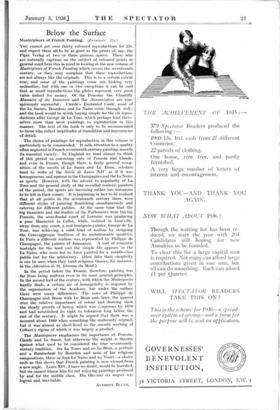Masterpieces of French Painting. (Zweiraner. 23s.)
Below the Surface
You cannot get over thirty coloured reproductions for 23s. and expect them all to be as good as the prints of, say, the Piper Verlag at two or three guineas apiece. Those who
are naturally captious on the subject of coloured prints in general must bear this in mind in looking at the new volume of Masterpieces of French Painting which covers the seventeenth century, or they may complain that these reproductions are not always like the originals. This is to a certain extent true, and some of the paintings come out looking very unfamiliar, but with one or two exceptions it can be said that as small reproductions the plates represent very good value indeed for money. Of the Pottcsins the Chantilly Massacre of the Innocents and the Annunciation are con- spicuously successful ; Claude's Enchanted Castle, most of the Le Sueurs, Bourdons and Le Nains come through well ; and the book would be worth buying simply for the six repro- ductions after George de La Tour, which perhaps lend them- selves more than most paintings to reproduction in this manner. The text of the book is only to be recommended to those who collect ineptitudes of translation and inaccuracies of detail.
The choice of paintings for reproduction in this volume is particularly to be commended. It calls attention to a quality often neglected in French seventeenth-century painting, namely its essential variety. In England we tend almost to think of this period as consisting only of Poussin and Claude, and even in France, though there is fairly general recog- nition of the merits of Le Sueur and Le Brun, scholars tend to write of the Siècle de Louis XIV as if it was homogeneous, and squeeze in the Champagnes and the Le Nains as sports. However, with the advent to popularity of La Tour and the general study of the so-called realistic painters of the period, .the sports are becoming rather too numerous to be left in their corner. It is beginning in fact to be realised that at all points in the seventeenth century there were different styles of painting flourishing simultaneously and catering for different publics. At the same time that the big financiers and the leaders of the Parlements were buying Poussin, the send-feudal court of Lorraine was producing a pure Mannerist in Callot, while, isolated in Luneville, away from any court, a real bourgeois painter, George de La Tour, was achieving a solid kind of realism by stripping the Caravaggesque tradition of its melodramatic qualities. In Paris a different realism was represented by Philippe de Champagne, the painter of Jansenism. A sort of romantic nostalgia for the land and the simple life appears in the Le Nains, who seem not to have painted for a middle-class public but for the aristocracy. (How false their simplicity is can be seen when they treat religious themes, for instance, in the Adoration in St. Etienne du Mont.) In the period before the Fronde, therefore, painting was far from being uniform even in its most general principles. In the second half of the century, with which the Masterpieces hardly deals, a certain air of homogeneity is imposed by the organisation of the Academy, but under the surface there were many differences. The rows of Philippe de Champagne and Bosse with Le Brass and, later, the quarrel over the relative importance of colour and drawing show the steady growth of heresy which was dangerous by 1670 and had established its right to toleration long before the end of the century. It might be argued that there was a moment about 1660 when something like uniformity reigned, but it was almost as short-lived as the smooth working of Colbert's regime of which it was largely a product.
The Masterpieces emphasises the importance of Poussin, Claude and Le Sueur, but otherwise the weight is thrown against what used to be considered the true seventeenth- century tradition. Six La Tours and no Le Brun, a portrait and a Bermbochade by Bourdon and none of his religious compositions, three or four Le Nains and no Vouet—a choice such as this shows that French painting is now viewed from a new angle. Louis XIV, I have no doubt, would be horrified, but we cannot blame him for not enjoying paintings produced by and for the middle class. His Otez-moi ces magots was logical and inevitable.
ANTHONY BLUNT.










































 Previous page
Previous page